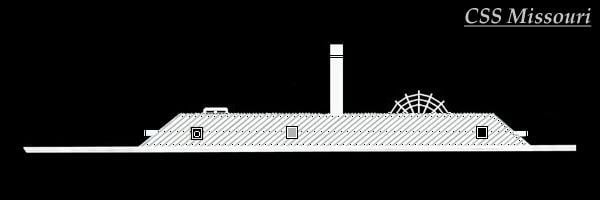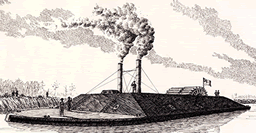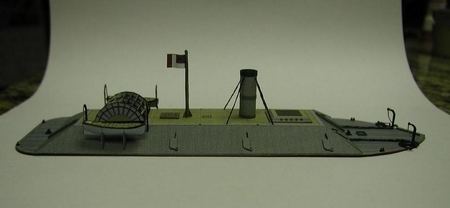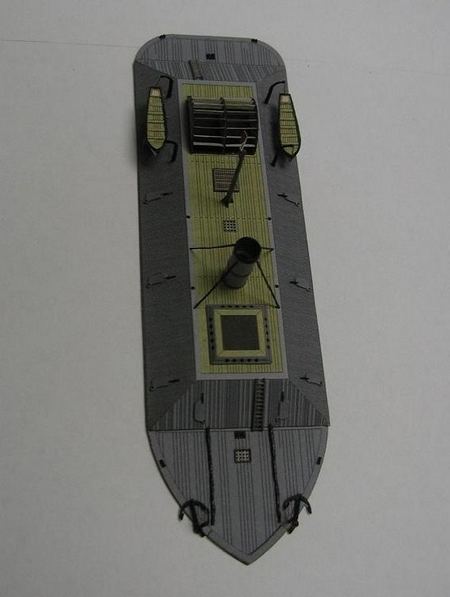Ordered 1 November 1862 Laid down December 1862 Launched 14 April 1863 | Commissioned 12 September 1863 Construction started December 1862 Length 56 m | |
 | ||
Fate Surrendered 3 June 1865Sold 29 November 1865 | ||
CSS Missouri was a Confederate States Navy casemate ironclad paddle steamer deployed on the Red River during the American Civil War. For most of the war she was trapped in the Shreveport, Louisiana area by low water on the Red River. The ship was surrendered in June 1865 to the United States Navy and sold in November.
Contents

Description

Missouri was 183 feet (55.8 m) long overall, had a beam of 53 feet 8 inches (16.4 m) and a draft of 8 feet 6 inches (2.6 m). Her casemate extended for most of the length of the ship and was 130 feet 6 inches (39.8 m) long. It partially enclosed her 22-foot-6-inch (6.9 m) diameter center paddle wheel in a recess at the aft end of the casemate; the upper 8 feet 4 inches (2.5 m) of the paddle wheel protruded above the casemate and was totally unprotected. The stern wheel was powered by two steam engines taken from the steamboat Grand Era; four boilers provided steam to the engines and were connected to a single funnel. The ship had a maximum speed of 6 miles per hour (5.2 kn).

Missouri's armor consisted of railroad "T-rails", laid alternately with the crowns up and down. They were spiked to the backing of 23-inch (580 mm) of yellow pine, but not closely together enough to give them a solid surface. On the sides of the ship, they were laid diagonally, but were vertical on the bow and stern faces of the casemate. The armor extended approximately 6 feet (1.8 m) below the waterline. The casemate was sloped at an angle of 30°. The deck fore and aft of the casemate was also protected by "T-rails". At the forward end of the casemate was a pilothouse that was raised 19 inches (480 mm) above the Deck. She was built of green timber, caulked with cotton and leaked like a sieve. Despite her three rudders, her stern wheel made her difficult to steer.

The casemate had eight gun ports, two in the bow face and three on each side, although only three guns were mounted in the ship. A smoothbore 11-inch (279 mm) Dahlgren pivot gun was mounted in the starboard forward position. It could fire out of the starboard bow port or the forward starboard broadside port. It weighed approximately 16,000 pounds (7,300 kg) and could fire a 136-pound (61.7 kg) shell up to a range of 3,650 yards (3,340 m) at an elevation of 15°. An old 32-pounder (14.5 kg) siege gun was in the equivalent position on the port side of the ship. The characteristics of this gun cannot be reliably determined because the United States produced a multitude of 32-pounder guns before the Civil War, but none of them were designated as siege guns. The third gun was a smoothbore 9-inch (229 mm) Dahlgren pivot gun that could fire out of either of the two aft broadside gun ports. It weighed approximately 9,200 pounds (4,200 kg) and could fire a 72.5-pound (32.9 kg) shell up to a range of 3,357 yards (3,070 m) at an elevation of 15°.
Construction and service

The Confederate Navy Department authorized the construction of one or more ironclad warships at Shreveport on 3 October 1862 and Lieutenant Jonathan H. Carter signed a contract for two ships on 1 November. The keel of the first ship was laid the following month and she was launched on 14 April 1863. The ship was commissioned on 12 September 1863 with the name of Missouri, after the high water season on the Red River had ended. Lieutenant Commander Charles Fauntleroy was appointed as her captain, although he told Lieutenant Carter that "he hoped the damned boat would sink" and that he "never intended to serve on her if he could help it". The low water prevented Missouri from playing any part in the Red River Campaign of early 1864. In September, Lieutenant Carter commanded an unsuccessful attempt to seize the gunboat USS Rattler using men from the crews of Missouri and CSS Webb.

In March 1865, the river began to rise and Missouri was able to leave the Shreveport area for the first time. She reached Alexandria, Louisiana on 8 April and anchored where she could defend the town. Captain Carter surrendered the ship to Union forces on 3 June, the last Confederate ironclad to surrender. After her armor was removed, Missouri was sold at public auction on 29 November.

